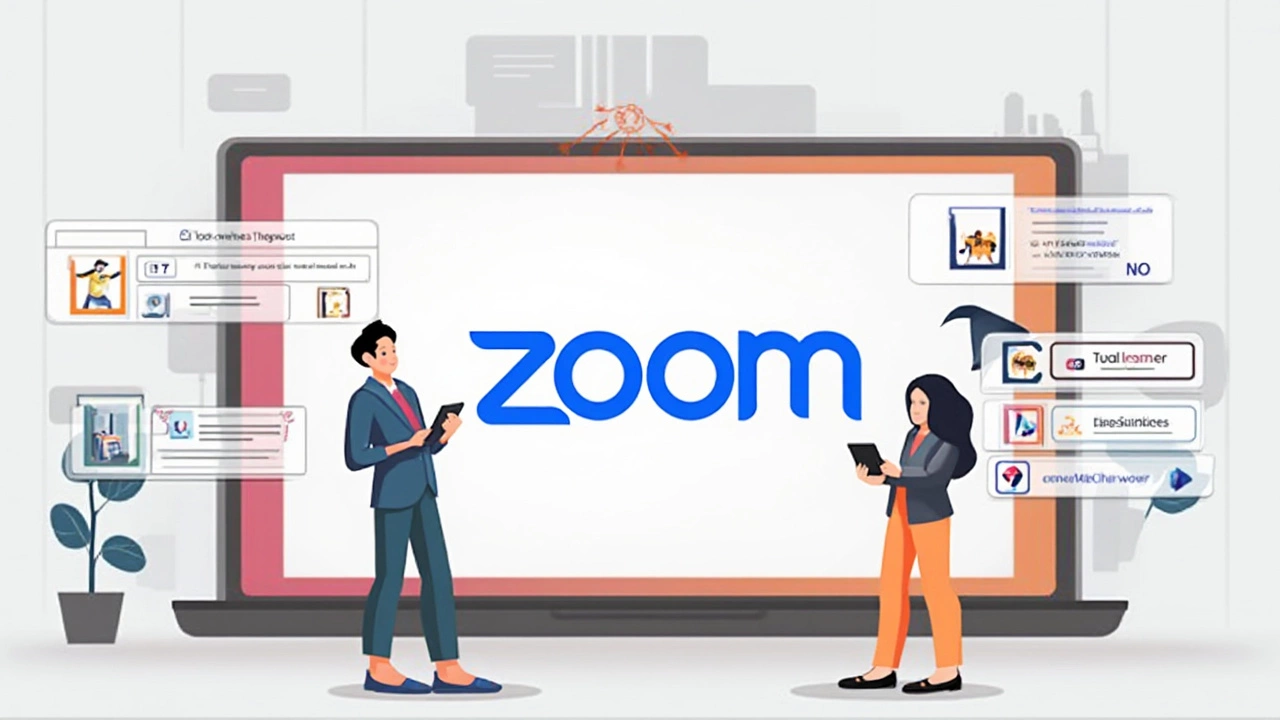Think about the last time you joined an online class. The platform probably wasn’t some obscure, fancy software—it was likely Zoom. That’s not just by chance. By 2025, Zoom has edged out the competition to become the leading choice for virtual classrooms, from big universities to after-school math clubs.
But why does everyone seem glued to this one platform? For starters, it’s not just about video calls. Zoom makes it shockingly easy to join or host classes, no matter if you’re on a laptop or using your phone at the kitchen table. People like things that just work, especially when tech headaches are already so common in education.
If you’re wondering whether you should stick with Zoom or consider another option, keep reading. I’ll walk you through key stats, the real reasons behind Zoom’s rise, and tips to make your next online class smoother, faster, and way less stressful.
- A Look at the Numbers: Who’s Leading the Race?
- Why Zoom Dominates the E-Learning Scene
- Smart Tips for Using Online Class Platforms
- What’s Next for E-Learning Tools?
A Look at the Numbers: Who’s Leading the Race?
If you check out the stats for 2024 and early 2025, there’s a clear winner for online classes. Zoom hosts over 350 million daily meeting participants, according to the company’s publicly released figures. These aren’t just work calls—schools, colleges, and training centers make up a huge chunk of that number. Zoom’s education tools and reliable streaming pull in millions of teachers and learners each day.
Google Meet sits in second place, mostly used by K-12 schools because it’s bundled with Google Workspace for Education. In the US, about 57% of public schools say they used Google products in the past year for instruction. Microsoft Teams, while popular in the corporate world, claims about 270 million monthly active users, but a smaller slice is dedicated to actual learning.
Other platforms like Canvas, Blackboard, and Moodle are still in the mix, but these work more as learning management systems. They’re great at storing assignments, grading, and sharing resources, but don’t handle live classes as well or as simply as Zoom does. When it comes to hosting live lessons, lectures, or tutoring, Zoom is the clear first choice in 2025.
Here’s a quick snapshot:
- Zoom: 350+ million daily meeting participants
- Google Meet: Used by over half of US public schools
- Microsoft Teams: 270 million monthly users (fewer for education)
- Canvas/Blackboard/Moodle: Mostly for assignment management, not live classes
The numbers really do tell the story. People just want something that works for live sessions, and Zoom’s simple “click-to-join” feature keeps it ahead of the pack.
Why Zoom Dominates the E-Learning Scene
It’s not just hype—there’s real meat behind why online classes flock to Zoom like it’s the only game in town. Teachers and students want something that’s simple, reliable, and quick to learn, which happens to describe Zoom almost perfectly.
A big draw is Zoom’s user-friendly interface. You don’t need to fumble through buttons trying to find the mute. Everything’s labeled in plain English, and the design looks the same whether you’re on a computer, tablet, or phone. That’s huge for schools that are juggling a mix of devices and tech skill levels.
Breakout rooms have changed the game for group work. No more awkwardly trying to organize teams in a big digital room. A teacher can split everyone into small groups with one click, making it easy for kids to actually talk and work together—stuff you want in a real class. And when it comes to integrating with school systems, Zoom plugs right into popular tools like Google Classroom, Canvas, and even calendars for reminders.
It’s not just about the basics. Zoom has ramped up security after being in the headlines for all the wrong reasons back in 2020. Now password-protected meetings, waiting rooms, and automatic updates come standard. It makes teachers feel a bit safer letting younger kids in, and nobody has to worry about surprise guests ruining the lesson.
If you’re curious about reach, check out these numbers:
| Platform | Monthly Active Users (2025) | Max Participants Per Session |
|---|---|---|
| Zoom | 350 million+ | 1,000+ |
| Microsoft Teams | 280 million | 1,000 |
| Google Meet | 200 million | 500 |
Sure, other platforms have their perks, but Zoom’s flexibility is hard to beat. Want to record your classes? Two clicks. Need real-time captions for accessibility? Built-in. Even bandwidth isn’t a deal-breaker—Zoom keeps video steady even on slower connections. That’s a lifesaver if your Wi-Fi isn’t playing nice.
Here are a few perks that keep Zoom ahead in the e-learning pack:
- No weird downloads for guests—most browsers work just fine.
- Virtual backgrounds mean privacy for those learning in cramped spaces.
- Regular updates keep features fresh and bugs squashed.
Put simply: Zoom blends all the stuff teachers and students want, minus the things that make people groan. That’s why you hear its name every time someone mentions virtual school.

Smart Tips for Using Online Class Platforms
Getting the most out of your online classes platform isn’t just about logging in and hoping for the best. There are some tricks that can turn a boring, glitch-filled lesson into something smooth and way more productive.
First, double-check your gear before every class—yes, even if you used it yesterday. Sometimes Zoom or Google Meet changes settings after updates, or your mic mysteriously gets muted. Run a quick test call by yourself or with a friend. That simple step cuts down on embarrassing tech issues when everyone’s watching.
If you’re teaching, try not to stick with just lecturing. Use built-in features like breakout rooms, polls, and the chat box. Students stay more engaged when they actually do things instead of just listening. According to a study from Class Technologies Inc. last year, online classes with interactive features kept students attentive twice as long as those without.
Here are some moves that work for both teachers and students:
- Mute when not talking: Background noise ruins focus for everyone.
- Use the hand raise feature: It stops people from accidentally talking over each other.
- Keep your camera on: If your connection allows, it feels more like a real room—and fewer people drift off.
- Share your screen using split view: That way, you can see class materials and everyone’s faces at the same time.
- Prep files before joining: Have PDFs or slides open so you’re not hunting for them mid-class.
- Try closed captions: Platforms like Zoom and Microsoft Teams offer real-time captions, great for accessibility and catching details.
Pro tip: If you constantly have connection issues, try plugging your device straight into your home router instead of using Wi-Fi. It’s a lifesaver in group discussions or exam reviews.
Last thing—always use the platform’s recording feature if the class allows it. So many students (my husband Nolan included!) swear by rewatching lectures, especially right before tests. Just make sure everyone’s cool with being recorded.
What’s Next for E-Learning Tools?
Just when you think online classes can’t change much, new tech is already shaking things up. AI tutors and virtual reality (VR) classrooms are getting plenty of buzz in 2025, and it's more than just hype. Pearson and Coursera, for example, have started blending AI support into their courses. That means students can now get instant feedback on essays, or personalized quizzes that adapt to their levels. This saves teachers a truckload of time and helps learners work at their own pace.
VR is another space to keep an eye on. Meta and several startups have rolled out virtual classrooms where you can walk around, look at 3D models, and even dissect digital frogs if that’s your thing. While the headsets aren’t everywhere just yet, pilot programs in schools are growing, especially for science and tech lessons where seeing things in three dimensions really matters.
If you’re planning to upgrade your own setup or teach online, consider tools that offer more flexibility. Look for features like:
- AI-driven recap tools (think: automatic notes and summaries)
- Interactive whiteboards that don’t lag like they used to
- Easy screen-sharing and breakout rooms
- Mobile support—because not every student has a fancy laptop
And don’t forget data privacy. As these platforms grow smarter, there’s more of your information floating around. Always check what kind of data the tool collects and how safe it keeps it. Most big platforms are ramping up privacy controls, but it pays to stay alert.
In short, the future of e-learning will be less about sitting and staring at a screen, and more about doing, moving, and interacting. Whether you’re an educator or a student, staying curious and trying out new tools is the best way to keep up. Things are changing fast, and that’s actually pretty exciting.





